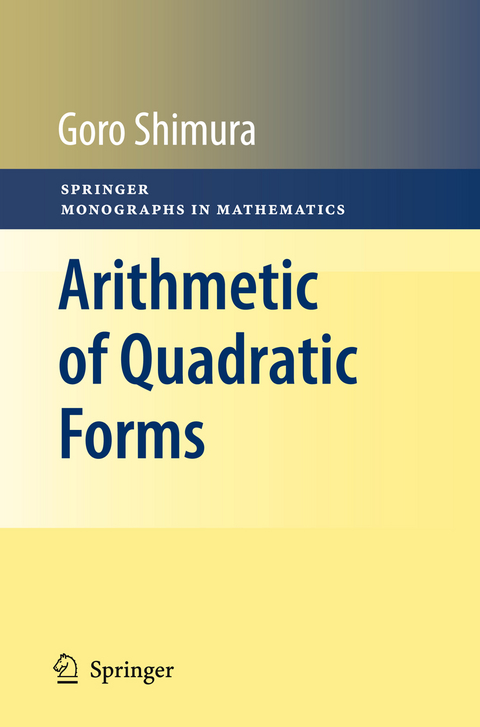
Arithmetic of Quadratic Forms
Seiten
2012
Springer-Verlag New York Inc.
978-1-4614-2618-9 (ISBN)
Springer-Verlag New York Inc.
978-1-4614-2618-9 (ISBN)
Topic (A) can be further divided into two types of theories: (a1) Classi?cation over an algebraic number ?eld; At some point we need the Hasse norm theorem for a quadratic extension of a number ?eld, which is included in class ?eld theory. We prove it when the base ?eld is the rational number ?eld to make the book self-contained in that case.
This book can be divided into two parts. The ?rst part is preliminary and consists of algebraic number theory and the theory of semisimple algebras. The raison d’ˆ etre of the book is in the second part, and so let us ?rst explain the contents of the second part. There are two principal topics: (A) Classi?cation of quadratic forms; (B) Quadratic Diophantine equations. Topic (A) can be further divided into two types of theories: (a1) Classi?cation over an algebraic number ?eld; (a2) Classi?cation over the ring of algebraic integers. To classify a quadratic form ? over an algebraic number ?eld F, almost all previous authors followed the methods of Helmut Hasse. Namely, one ?rst takes ? in the diagonal form and associates an invariant to it at each prime spot of F, using the diagonal entries. A superior method was introduced by Martin Eichler in 1952, but strangely it was almost completely ignored, until I resurrected it in one of my recent papers. We associate an invariant to ? at each prime spot, which is the same as Eichler’s, but we de?ne it in a di?erent and more direct way, using Cli?ord algebras. In Sections 27 and 28 we give an exposition of this theory. At some point we need the Hasse norm theorem for a quadratic extension of a number ?eld, which is included in class ?eld theory. We prove it when the base ?eld is the rational number ?eld to make the book self-contained in that case.
This book can be divided into two parts. The ?rst part is preliminary and consists of algebraic number theory and the theory of semisimple algebras. The raison d’ˆ etre of the book is in the second part, and so let us ?rst explain the contents of the second part. There are two principal topics: (A) Classi?cation of quadratic forms; (B) Quadratic Diophantine equations. Topic (A) can be further divided into two types of theories: (a1) Classi?cation over an algebraic number ?eld; (a2) Classi?cation over the ring of algebraic integers. To classify a quadratic form ? over an algebraic number ?eld F, almost all previous authors followed the methods of Helmut Hasse. Namely, one ?rst takes ? in the diagonal form and associates an invariant to it at each prime spot of F, using the diagonal entries. A superior method was introduced by Martin Eichler in 1952, but strangely it was almost completely ignored, until I resurrected it in one of my recent papers. We associate an invariant to ? at each prime spot, which is the same as Eichler’s, but we de?ne it in a di?erent and more direct way, using Cli?ord algebras. In Sections 27 and 28 we give an exposition of this theory. At some point we need the Hasse norm theorem for a quadratic extension of a number ?eld, which is included in class ?eld theory. We prove it when the base ?eld is the rational number ?eld to make the book self-contained in that case.
The Quadratic Reciprocity Law.- Arithmetic in an Algebraic Number Field.- Various Basic Theorems.- Algebras Over a Field.- Quadratic Forms.- Deeper Arithmetic of Quadratic Forms.- Quadratic Diophantine Equations.
| Reihe/Serie | Springer Monographs in Mathematics |
|---|---|
| Zusatzinfo | XII, 238 p. |
| Verlagsort | New York, NY |
| Sprache | englisch |
| Maße | 155 x 235 mm |
| Themenwelt | Mathematik / Informatik ► Mathematik ► Algebra |
| Mathematik / Informatik ► Mathematik ► Arithmetik / Zahlentheorie | |
| Mathematik / Informatik ► Mathematik ► Wahrscheinlichkeit / Kombinatorik | |
| Schlagworte | Clifford Algebras • Quadratic Diophantine equations • quadratic forms • Quadratic reciprocity law • Semisimple algebras • Strong approximation • Sums of squares |
| ISBN-10 | 1-4614-2618-9 / 1461426189 |
| ISBN-13 | 978-1-4614-2618-9 / 9781461426189 |
| Zustand | Neuware |
| Haben Sie eine Frage zum Produkt? |
Mehr entdecken
aus dem Bereich
aus dem Bereich
Buch | Softcover (2022)
Springer Spektrum (Verlag)
39,99 €


